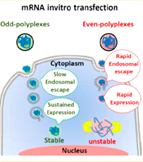Research Highlights
Vol.4, Jun 2015
Fine-tuning of chemical structure of mRNA carriers for clinical application
Messenger RNA (mRNA) has been paid attention as a potential candidate for nucleic acids drug. However, the very labile nature of mRNA has hindered its clinical application. Polyion complex formed from mRNA and polycations, which is termed ‘Polyplex’, can protect mRNA from enzymatic degradation and enhance its cellular uptake. Fine-tuning of the chemical structure of polycations dramatically improve the ability of polyplex to deliver mRNA.
Prof. Kazunori Kataoka and co-workers at the University of Tokyo synthesized the polyaspartamides possessing the different number of aminoethylene repeats in their side chain. By applying the polyaspartamides for mRNA carriers, they found that the polyaspartamides possessing odd number of aminoethylene repeats (PA-Os) provided more persistent protein expression compared with those possessing even number repeats (PA-Es).
Prof. Kataoka and his team also revealed that, despite lower capacity of endosomal escape than PA-Es, the carriers composed of PA-Os had high stability in the cytoplasm allowing retention of mRNA stably inside the carriers. Eventually, PA-Os can provide protein expression in a long and sustained manner. These feature are in sharp contrast to the case of DNA delivery, where PA-Es exhibited high capacity due to the facilitated endosomal escape.
The researchers concluded that the sophisticated molecular design of carriers is important for realizing clinical application using nucleic acids drugs.
Reference and affiliations
- 1. Hirokuni Uchida,† Keiji Itaka,† Takahiro Nomoto,‡ Takehiko Ishii,‡ Tomoya Suma,∥ Masaru Ikegami,† Kanjiro Miyata,† Makoto Oba,⊥ Nobuhiro Nishiyama,# and Kazunori Kataoka*,†,‡,§. Modulated protonation of side chain aminoethylene repeats in N substituted polyaspartamides promotes mRNA transfection. The Journal of the American Chemical Society 136 (2014)
†Center for Disease Biology and Integrative Medicine, Graduate School of Medicine,
‡Department of Bioengineering, Graduate School of Engineering, and §Department of Materials Engineering, Graduate School of Engineering, The University of Tokyo, 7-3-1 Hongo, Bunkyo, Tokyo 113-8656, Japan
∥Department of Chemical and Biomolecular Engineering, The University of Melbourne, Victoria 3010, Australia
⊥Graduate School of Biomedical Sciences, Nagasaki University, 1-14 Bunkyo-machi, Nagasaki 852-8521, Japan#Polymer Chemistry Division, Chemical Resources Laboratory, Tokyo Institute of Technology, R1-11, 4529 Nagatsuta, Midori-ku, Yokohama 226-8503, Japan
*corresponding author email address: kataoka@bmw.t.u-tokyo.ac.jp
Figure:







